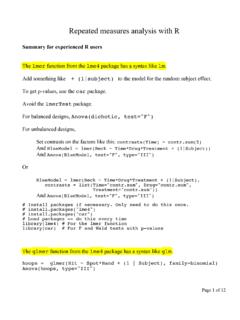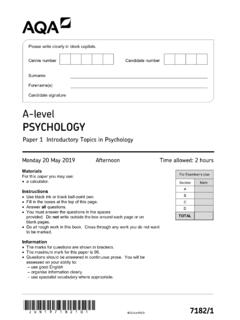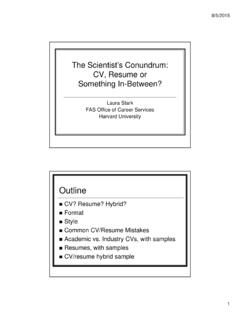Transcription of Statistical Power Analysis for the Behavioral Sciences
1 Statistical Power Analysis for the Behavioral Sciences Second Edition Statistical Power Analysis for the Behavioral Sciences Second Edition Jacob Cohen Department of psychology New York University New York, New York ~ LAWRENCE ERLBAUM ASSOCIATES, PUBLISHERS Copyright 1988 by Lawrence Erlbaum Associates All rights reserved. No part of this book may be reproduced in any form, by photostat, microform, retrieval system, or by any other means, without the prior written permission of the publisher. Library of Congress Cataloging-in-Publication Data Cohen, Jacob. Statistical Power Analysis for the Behavioral Sciences I Jacob Cohen. - 2nd ed. Bibliography: p. Includes index. ISBN 0-8058-0283-5 1. Social Sciences - Statistical methods. 2. Probabilities. I. Title. 1988 300'.1 '5195-dcl9 88-12110 Books published by Lawrence Erlbaum Associates are printed on acid-free paper , and their bindings are chosen for strength and durability. Printed in the United States of America 20 19 18 17 16 15 14 13 12 to Marcia and A viva Contents Preface to the Second Edition Preface to the Revised Edition Preface to the Original Edition Chapter 1.
2 The Concepts of Power Analysis General Introduction Significance Criterion Reliability of Sample Results and Sample Size The Effect Size Types of Power Analysis Significance Testing l. 7. Plan of Chapters 2-9 Chapter 2. The t Test for Means Introduction and Use The Effect Size Index: d Power Tables Sample Size Tables The Use of the Tables for Significance Testing Chapter 3. The Significance of a Product Moment r s 3 .1. Introduction and Use The Effect Size: r Power Tables vii xi xvii xix 4 6 8 14 17 17 19 20 27 52 66 75 77 83 viii CONTENTS Sample Size Tables The Use of the Tables for Significance Testing of r Chapter 4. Differences between Correlation Coefficients Introduction and Use The Effect Size Index: q Power Tables Sample Size Tables The Use of the Tables for Significance Testing Chapter 5. The Test that a Proportion is .SO and the Sign Test Introdction and Use The Effect Size Index: g Power Tables Sample Size Tables The Use of the Tables for Significance Testing Chapter 6.
3 Differences between Proportions Introduction and Use The Arcsine Transformation and te Effect Size Index: h Power Tables Sample Size Tables The Useof the Tablesfor Significance Testing Chapter 7. Chi-Square Tests for Goodness of Fit and Contingency Tables 7 .I. Introduction and Use 7 .2. The Effect Size index: w Power Tables 7 .4. Sample Size Tables Chapter 8. The Analysis of Variance and Covariance Introduction and Use The Effect Size lndex:f Power Tables Sample Size Tables The Use of the Tables for Significance Testing Chapter 9. Multiple Regression and Correlation Analysis Introdction and Use The Effect Size Index: f2 Power Tables 99 lOS 109 110 116 133 139 14S 147 ISO 166 17S 179 180 18S 204 209 21S 216 227 2S2 273 274 288 380 403 407 410 414 CONTENTS 9 .4. L Tables and the Determination of Sample Size Chapter 10. Set Correlation and Multivariate Methods Introduction and Use The Effect Size Index: f2 Determining the Power Determining Sample Size Chapter 11.
4 Some Issues in Power Analysis Introduction Effect Size Reliability "Qualifying" Dependent Variables Chapter 12. Computational Procedures ix 444 467 473 481 Sl4 S31 S31 S3S S37 lntrodction S43 t Test for Means S44 The Significance of a Product Moment r S4S Differences between Correlation Coefficient S46 The Test that a Proportion is .SO and the Sign Test S47 Differences between Proportions S48 Chi-Square Tests for Goodness of Fit and Contingency Tables S49 F Test on Means and the Analysis of Variance and Covariance SSO F Test of Variance Proportions in Multiple Regression/Correlation Analysis SSI References SS3 Index SS9 Preface to the Second Edition In the quarter century that has passed since I first addressed Power anal-ysis (Cohen, 1962), and particularly during the decade that has elapsed since the revised edition of this book (1977), the escalation of the literature on Power Analysis has been difficult to keep up with. In 1962, I published a survey of the articles in a volume of the Journal of Abnormal and Social psychology from the perspective of their Power to de-tect operationally defined small, medi~m, and large effect sizes [a meta- Analysis before the term was coined (Bangert-Drowns, 1986)].
5 I found rather poor Power , for example, a mean of .48 at the two-tailed .05 level for medium effect sizes. Since the publication of the first edition (1969), there have been two or three dozen Power surveys of either particular journals or topical areas, us-ing its tables and (more or less) the same method. In addition to the half -dozen cited in the Preface to the Revised Edition in 1977, which were in the fields of counseling psychology , applied psychology , education, speech and hearing, and mass communication, there are numerous Power surveys in many fields, for example: in educational research, in general education (Jones & Brewer, 1972), science education (Pennick & Brewer, 1972; Wooley & Dawson, 1983), English education (Daly & Hexamer, 1983), physical edu-cation (Christensen & Christensen, 1977), counselor education (Haase, 1974), social work education (Orme & Tolman, 1986) medical education (Wooley, 1983a), and educational measurement (Brewer & Owen, 1973). Power surveys have been done in social work and social intervention re-search (Crane, 1976; Judd & Kenny, 1981; Orme & Combs-Orme, 1986), in occupational therapy (Ottenbacher, 1982), abnormal psychology xi xii PREFACE TO THE SECOND EDITION (Sedlmeier & Gigerenzer, in press), personnel selection (Katzen & Dyer, 1977), and market research (Sawyer & Ball, 1981).
6 A fairly large number have been accomplished in medicine: in clinical trials (Freiman, Chalmers, Smith, & Kuebler, 1977; Reed & Slaichert, 1981), public health (Wooley, 1983b ), gerontology (Levenson, 1980), psychiatry (Roth pearl, Mobs, & Davis, 1981), and Australian medicine (Hall, 1982). Even further afield, a Power survey was done in the field of geography (Bones, 1972). In addition to these published surveys, there have come to my attention about a dozen unpublished dissertations, research reports, and papers given at profes-sional meetings surveying Power in psychology , sociology, and criminology. A corollary to the long neglect of Power Analysis is a relatively low awareness of the magnitude of phenomena in the Behavioral Sciences (Cohen, 1965). The emphasis on testing null hypotheses for Statistical significance (R. A. Fisher's legacy) focused attention on the Statistical significance of a result and away from the size of the effect being pursued (see Oakes, 1986; Gigerenzer, 1987; Chapter 11).
7 A direct consequence of the recent attention to Power , the last few years have witnessed a series of surveys of effect sizes: in social psychology (Cooper & Findlay, 1982), counseling psychology (Haase, Waechter, & Solomon, 1982), consumer behavior (Peterson, Albaum, & Beltramini, 1985),and market research (Sawyer & Ball, 1981). The recent emergence of meta- Analysis (Glass, McGaw, & Smith, 1981; Hedges & Olkin, 1985; Hunter, Schmidt, & Jackson, 1982; Kraemer, 1983) has been influenced by Power Analysis in the adoption of its effect size meas-ures (Bangert-Drowns, 1986), and in turn, has had a most salutary influence on research progress and Power Analysis by revealing the level, variability, and correlates of the effect sizes operating in the areas to which it is applied. The literature in Power -analytic methodology has burgeoned during this period; pertinent references are given throughout this edition. Among the many topics here are applied Power Analysis for: nonstandard conditions ( , non-normality, heterogeneous variance, range restriction), non-parametric methods, various multiple comparison procedures, alternative methods of combining probabilities, and alternative stabilizing data trans-formations.
8 There have been several articles offering simplified one-table methods of approximate Power Analysis including my own (1970) (which provided the basis for a chapter-length treatment in the Welkowitz, Ewen, & Cohen, 1982, introductory statistics text), Friedman (1982), and Kraemer (1985). The latter is particularly noteworthy in that it breaks new ground methodologically and is oriented toward teaching Power Analysis . In marked contrast to the scene a decade or two ago, the current editions of the popular graduate level statistics textbooks oriented to the social and biological Sciences provide at least some room for Power Analysis , and in-clude working methods for the most common tests. On the post-graduate front, as the word about Power Analysis has PREFACE TO THE SECOND EDITION xiii spread, many "what is it" and "how to do it" articles have appeared in jour-nals of widely diversified content, ranging from clinical pathology (Arkin, 1981) through applied psychology (Fagley, 1985) to biological community ecology (Toft & Shea, 1983).
9 Microcomputer programs for Power Analysis are provided by Anderson (1981), Dallal (1987), and Haase (1986). A program that both performs and teaches Power Analysis using Monte Carlo simulation is about to be pub-lished (Borenstein, M. & Cohen, J., 1988). It would seem that Power Analysis has arrived. Yet recently, two independent investigations have come to my attention that give me pause. Rossi, Rossi, and Cottril (in press), using the methods of my Power survey of the articles in the 1960 volume of the Journal of A bnor-mal and Social psychology (Cohen, 1962), performed Power surveys of 142 articles in the 1982 volumes of the direct descendents of that journal, the Journal of Personality and Social psychology and the Journal of Abnormal psychology . When allowance is made for the slightly different (on the aver-age) operational definitions of small, medium, and large effect sizes of the 1962 paper , there is hardly any change in Power ; for example, the mean Power at the two-tailed.
10 OS level for medium effect sizes of the 1982 articles was slightly above 500Jo, hardly different from the 48% in 1960. Generally, the Power surveys done since 1960 have found Power not much better than I had. Some fields do show better Power , but they are those in which subjects are easily come by, so the sample sizes used are larger than those in abnormal, personality, and social psychology : in educational re-search (Pennick & Brewer, 1972; Brewer & Owen, 1973), mass communica-tion (Chase & Baran, 1976), applied psychology (Chase & Chase, 1975), and marketing research (Sawyer & Ball, 1981). However, there is no comparison of Power over time in these areas. Sedlmeier and Gigerenzer (in press) also studied the change in Power since my 1962 results, using 54 articles in the 1984 volume of the Journal of Abnormal psychology . They, too, found that the average Power had not changed over the past 24-year period. In fact, when the Power of the tests using experimentwise significance criteria (not encountered in my 1962 sur-vey) were included, the median Power for medium effects at the.


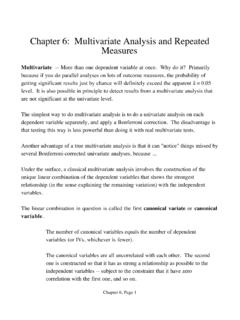

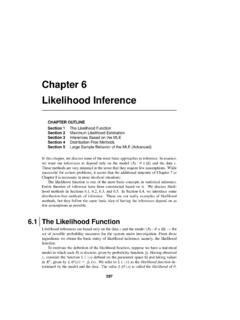
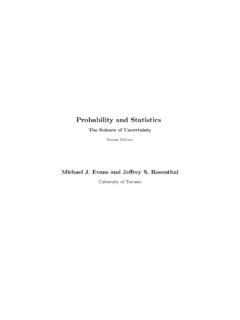
![Downloaded by [University of Toronto] at 16:20 23 May 2014 ...](/cache/preview/9/0/c/3/5/7/1/e/thumb-90c3571e5c0834844e82dee36d59b967.jpg)

